Michael McFadyen's Scuba Diving - Bare Island Deep Wall
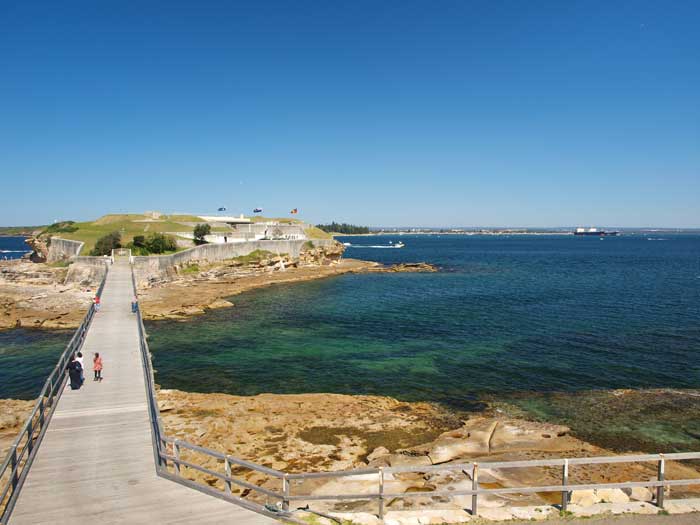 |
A photograph of Bare Island Right on a perfect day
The best entry point is at the far right of the island, to the left and above the rocks jutting out
The exit point is on the island just to the right of the bridge |
In Sydney, the location I have dived most is Bare Island (over 700 dives). There are many dives that you can do here. In this article I will describe another of these dives.
Located 20 kilometres from the centre of Sydney, Bare Island is part of Botany Bay National Park. From the city, travel along Anzac Parade or Bunnerong Road to La Perouse. Upon arriving at La Perouse, park on the edge of Anzac Parade above the island as close to the island's access road as you can. Walk to the edge of the headland overlooking the island to check the water conditions as well as the entry and exit points. This dive can be done in virtually all seas, even those from the south-east. I have dived here many times when surfers have been surfing off the eastern end of the bridge that joins the island to the mainland. It is only in the hugest of seas that you cannot dive this site. One thing that can affect the site is that after prolonged periods of very heavy rain, the visibility can be reduced to one or two metres.
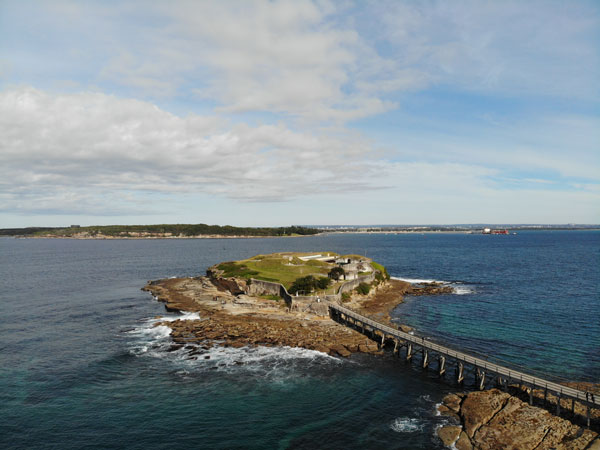 |  |
| A drone photograph of Bare Island from the north | A drone photo of Bare Island from the west |
If you asked me back in the mid-1990s I would have said that even at its best, the visibility only got to four or five metres. However, since about 1999, visibility here has improved dramatically. In 2002 I dived here 10 times. The visibility averaged almost 10 metres on these dives which is certainly much better than the previous 13 years. In May 2003 I dived here and had 15 metres and in December 2003, January 2004 and December 2005 I had at least 20 metres on the deeper reef. The tides do not really have much impact on a dive although sometimes an outgoing tide can cause a current in the deep section of the dive. This is normally when there has been a very large high tide. Visibility is sometimes better on high tide but I have also had good visibility at low tide.
 |  |
A satellite photograph of Bare Island showing the reef
Entry point is far left of the island | A map of Bare Island (Right)
Click to enlarge |
 | 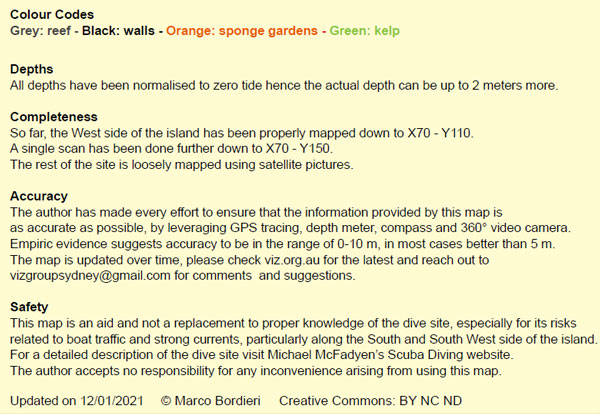 |
A new underwater map of Bare Island created by Marco Bordieri from www.viz.net.au.
For a much larger pdf version of this map, click here.
Used with permission of Marco Bordieri | Information about the map at left and below |
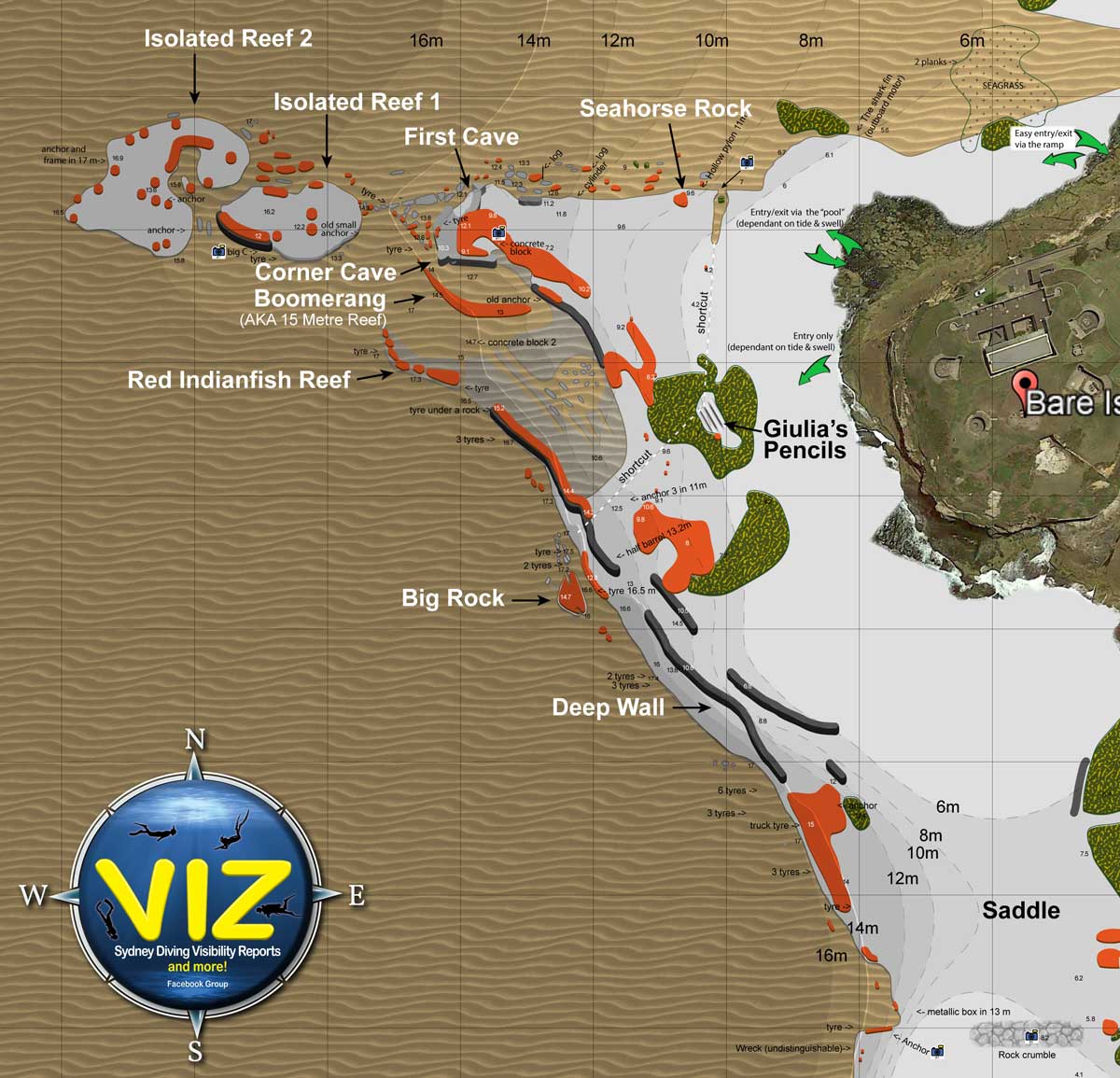 |
A new underwater map of the western side of Bare Island created by Marco Bordieri from www.viz.net.au.
For a much larger pdf version of this map, click here.
Used with permission of Marco Bordieri |
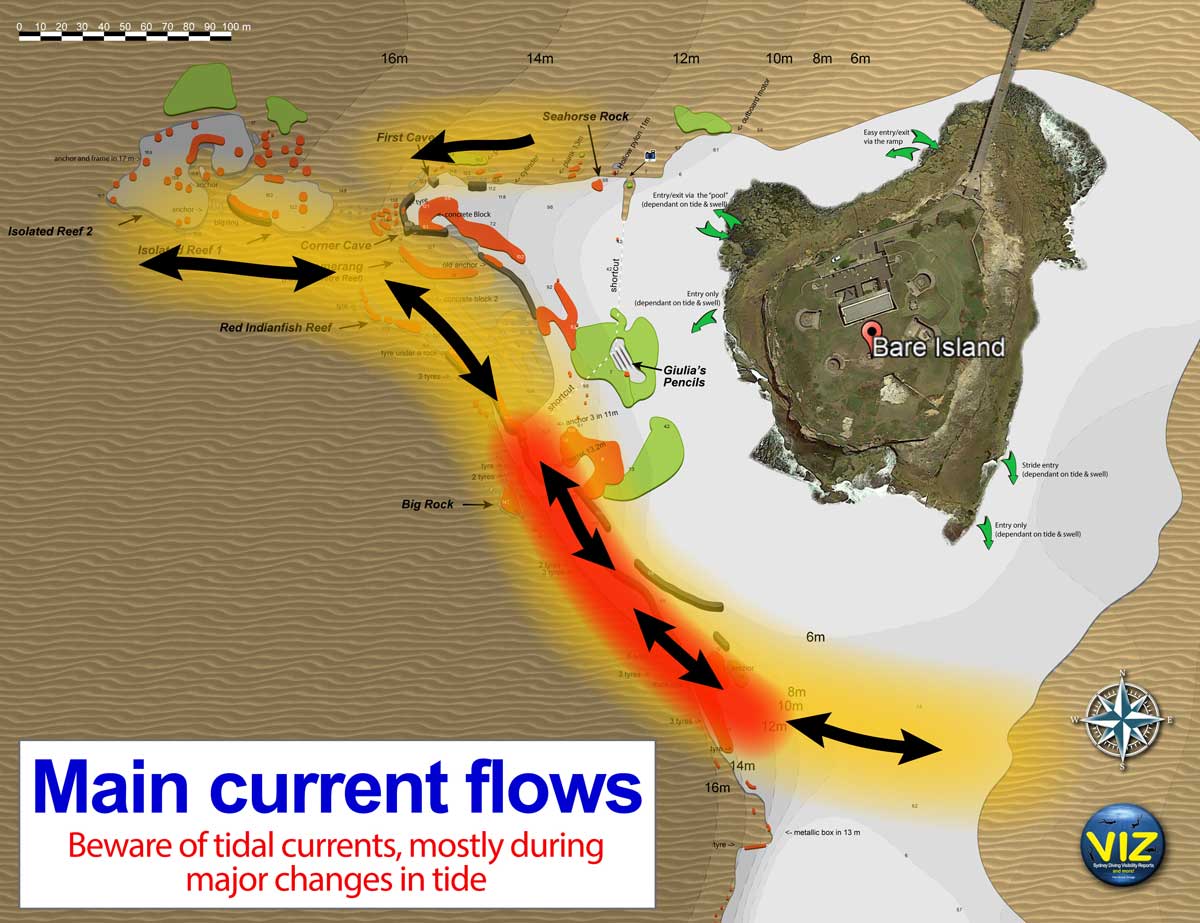 |
This shows the predominant tidal currents at Bare Island. Incoming are the currents to left, outgoing to right. Created by Marco Bordieri from www.viz.net.au using my information.
Used with permission of Marco Bordieri |
BARE ISLAND DEEP WALL
BASIC DIVE
There are at least five ways to do this dive from the shore and you can do it from a boat. The various options are:
First Option - The Boat Ramp - FIRST TIME HERE
The best way for divers new to this site is to start at the small boat ramp as per the Bare Island Right dive. From here, swim across the sand in a westerly direction till you hit the main reef (depth about 5 to 6 metres). Then follow it past Sea Horse Rock (11 to 12 metres - but now no sea horses there) to the First Cave (14 metres) and then the Second Cave. Note that the way I describe this dive, the return uses the directions from the Bare Island Right dive from this location.
Once at the Second Cave, swim about 15 metres further along and you will see Sea Horse Corner or Cave (heaps of sea squirts and overhangs). This is right on the corner of the main Bare Island Reef. There used to be lots of sea horses here but there is now only the occasional one. Turn left and swim for about 20 metres along the edge of the main Bare Island Reef. You will probably see a couple of bits of timber or metal (not sure which) sticking up about 150 to 200 mm out of the sand. One is close to the reef and the other about 1.5 metres away. These point roughly to the south. Follow this direction and leave the reef.
Within 10 metres you will cross a small section of reef and a small wall about 0.5 metres high and should see what appears to be a large anchor (15 metres) with some chain or rope running out to the south-east (hard to tell as it is totally covered in growth). I do not think this is an anchor as there are other bits buried under the sand but there is definitely rope or chain running out. Perhaps it is a fish trap that has rusted and later buried under the sand. Note that in February 2006 I could not find this but there was a boat or pool ladder on the sand. Follow the direction of the piece you can see (that is south).
You will cross another section of sand that slopes down. This is in a similar area to where the third option to dive this site (see later) meets the sand. After about 30 metres you will start to see marine growth and then some reef. The depth has increased to about 16.5 metres. This is a small wall that runs to the south-east. Note where you meet this wall for the return trip. You should see a very large low rock on the sand a metre or so off the wall with a low overhang on the south-eastern corner and a large car tyre between the rock and the wall.
On 6 March 2008, we found the wreck of a fibreglass half-cabin boat here. It appeared to have been in the water only a couple of days. It was jammed between the two sections of reef. The motor, auxiliary motor, radio and everything else was missing. The bung was also missing. There was no apparent damage to cause it to sink. However, I later heard that NSW Maritime had a report that a boat had engine problems and rolled onto a reef somewhere near here. What happened to the engines is hard to fathom. Very suspicious! Anyway, on 27 April 2008, it was gone. There was some damage to the reef on the western side of where the wreck was located as if the wreck had been bumping it. We searched for about 40 metres to the west, north-west and north but found no side at all of it or damage to the reef if it had been dragged over it. What happened to it? I later heard that it was salvaged.
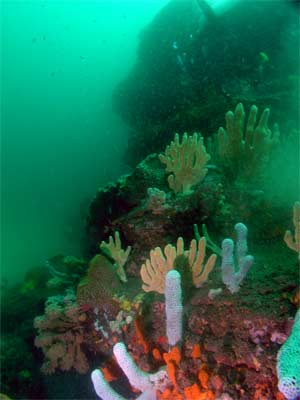 |  |
| Two photos of the Deep Wall at Bare Island |
The sand here is about 17.5 metres deep. Follow the wall to the left towards the south-east. The depth increases to 18 and then 18.5 metres (at high tide). All along the wall there are lots of sea squirts and sponges similar to the photograph above. After about 20 metres (20 kick cycles for me) you will see a rock that sticks out a little from the reef (like a point). There is a piece of aluminium and a I_I shaped piece of timber about 1 m long on each side here. If you are unsure of the location, if you come across two tyres in the sand right next to the reef, go back a metre or so. If you come across a small Admiralty anchor (The Anchor) a few metres off the main reef, you are about 10 metres past the spot. From November 2005 to February 2006 there were at least two white pygmy pipehorses (see photos below) in this area. There were also at least two tiny pink/red ones here as well. The larger ones were about 25 mm long and the smaller ones about 10 mm. From October 2008 till July 2009 there were two medium sized red ones here. Search the whole top and side of the reef. Look carefully in the reddish weed, they blend in very well (except of course the white ones).
You can go a little further along the wall but if you (like me) have stopped to take some photos and look for more pygmies, then you probably want to turn around here. If you do this, you can take your time returning to the shore and explore a bit as I will further explain. Note that all five shore dives follow this same return trip.
To return to shore, swim back along the wall, this time in a roughly north-westerly direction. When you see the tyre between the rock and wall, turn right and head north across the sand. You will be going up a sort of "dry creek bed" or very shallow valley. There are normal spiny gurnards on the sand here.
You will come to the smaller wall or ledge (but probably not see the "anchor"). This is about 14 to 15 metres. In this area, look for pygmy pipehorses and red Indianfish on this reef.
On 11 January 2010, Kelly and I were scared out of our wits here by a very large seal that came out of the gloom (it was a twilight dive) and swam over and around us for a few seconds before disappearing up to the surface. It was a great thing to see, but I wish he had come in a bit slower!
 |  |
| Baby pygmy pipehorse on Deep Reef - May 2006 | The anchor on the Deep Wall |
From here follow the ledge to the left (westerly) and after 20 metres it takes a small turn to the right before turning left again. After another 15 metres it again turns to the left and sort of stops. Along this section you can sometimes see sea horses. From here, in good visibility (20 metres or better) you will see the main Bare Island Reef off to the north-north-east. Swim over and the depth will be back to about 14 metres. You should come across the overhangs near the corner (we call it Sea Horse Corner or Cave) this is the logical end of the reef if coming from the bridge as per Bare Island Right dive.
In poor visibility you will have to be a bit careful to ensure you do not keep following the 15 metre ledge across to the smaller rocks which takes you away from the main reef to the Bare Island Isolated Reefs mentioned above. Head north once at the corner and have a look in this area for sea horses (as I mentioned we call it we call it Sea Horse Corner or Cave). There are normally one or two here (November 2005 to May 2006) and I have seen up to six or seven but since 2010 we have only seen one every now and then. See the Bare Island Right dive for more information. You will then pass the two caves. Head out away from the first cave and there are some rocks and sections of reef that are home to some very nice fixed marine life and heaps of different nudibranches can be seen on the growth.
 |  |
| Pygmy pipehorse on Deep Reef | Two pygmy pipehorses on Deep Reef
The bottom one is the one in the photo at left |
From here it is a matter of following the reef all the way back to the boat ramp on Bare Island (that is the opposite of the way you came out if you did dive 1).
Note that there can sometimes be strong currents in the 16 to 19 metre depth. If you encounter this, be very careful and alter the dive to not include the Deep Wall. High tide offers less or nil current and best visibility, but other tides can also be very good. This dive will take at least 50 minutes and more like 60 minutes, even if you do not spend too much time at the deep wall and loitering on the way back. You will need good air consumption and should take a large tank rather than a small one.
Second Option - The Pool - FOR DIVERS EXPERIENCED WITH RIGHT SIDE DIVE
The second option is to walk out to the far western point of the island and enter the water in the sort of pool that is formed by the two piles of rocks just inside the actual point. Once in the water, swim out on the surface through the "heads". At low tide, the bottom is very shallow and you may need to haul yourself over the rocks.
 |  |
| A drone photograph of Bare Island from the north | A drone photo of the entry points for options 2 and 3 to 5
3 to 5 is the bottom right corner of rock platform, 2 is the pool which is fairly obvious |
Once in deeper water, descend and head to the west. You will soon drop to five metres and within a minute you should be on the sand at about seven metres. Turn left and follow the reef edge in a roughly westerly direction. Beware that if you end up with high reef on your right side, you have strayed into the gully that runs to the south and you will need to head north to reach the edge of the reef.
Go past Sea Horse Rock to the Cave. Follow the directions from the First Option above for the rest of the dive. Note that this dive will take about 55 minutes. It is more suitable to divers who are not so good on their air as there is less distance to swim. Again, I would recommend a large tank.
Third Option - Western Point - AFTER DIVING HERE VIA FIRST OR SECOND OPTION
The third option is to walk out to the far western point of the island and enter the water from the actual point. I would not start here until you have done the dive at least once as per one of the above starts (or are with someone experienced in doing the dive this way). You must be very good on your air consumption and navigation. In reality, this dive uses less air than the others but as you are quicker to 18 metres, you have the potential to use lots more and you are a long way from the exit spot. You will need extremely calm seas to do this dive (and the following dives) and good navigation skills as you come back a totally different way to how you get there.
Enter the water and snorkel out 10 or 15 metres till the water deepens. After descending, it is fairly shallow (3 metres) and not all that interesting. Head to the west (or just a bit south) and eventually you will reach the sand edge of the main reef at about 14 metres. This is just to the south of the Sea Horse Cave mentioned in Option One. Head south from here and you will cross the sand and the 15 metre reef and then find the deeper wall at 17 or 18 metres. Once at this depth, turn left and head south-east and south for a little while, say 20 metres, and you should find the pygmy pipehorses as explained in the First Option.
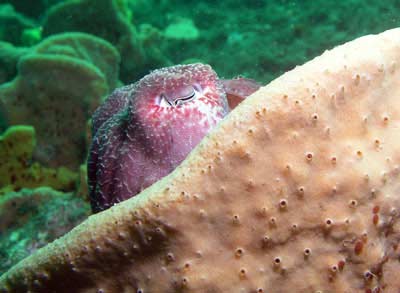 | 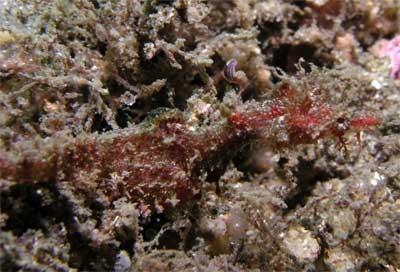 |
| A cuttlefish on the Deep Wall hiding in a sponge on the Deep Wall | Pygmy pipehorse on 15 metre ledge |
For a longer dive here, the directions are as follows. At first the wall is low. There used to be a small Admiralty anchor just off the reef here (see photo above - past the pygmy pipehorses) but some idiots moved it (and damgeed it greatly). As you go, the wall becomes more prominent and there are some overhangs, cracks and even a small cave. On the sand there are also some isolated rocks. Along this section of reef there are sea dragons and in some spots, very prolific fishlife. NOTE: Virtually no sea dragons seen on this dive since 2009 despite dozens of dives.
On your first dive here do not go too far (say 10 minutes) before turning around but if you are experienced, good on air and been here before, you can go quite a way before turning around. Past here the wall becomes a little less prominent for about 30 metres and then the wall is high again. There are some cracks and small overhangs here as well as some more rocks off the reef, including a couple of large ones. Just past here the wall again becomes less prominent right on the sand. The reef starts running south-east then south and after about 20 metres the wall is again more prominent. There are even more overhangs, cracks and even a couple of swim-thoughs here. There are also a couple of huge boulders on the sand. After this the reef heads south and then a little to the south-west and the wall again becomes less prominent. I would not go too far before turning back to the north, but you will never get this far (I used a scooter).
Follow the directions from the location of the pygmy pipehorse in First Option above for the return. Note that this dive will take at least 55 minutes, and up to 70 minutes if you go south from the first wall. The dive just to the pygmy pipehorse area is more suitable to divers who are not so good on their air as there is less distance to swim but because it goes quicker to depth, not for inexperienced divers. Again, I would recommend a large tank.
Fourth Option - Western Point - IF THERE IS A BIT OF AN OUTGOING TIDE
The fourth way to do this dive is to walk right to the back right (western) side of Bare Island as per the last option. Enter the water and swim out for 15 metres. Once you descend, head just south of west. The depth at first is four or five metres and it increases to 12 metres over 3.5 minutes before sloping more gradually to about 15 metres over the next two minutes. The bottom is rock with kelp and then sand with isolated rocks. After five and a half minutes you should hit a deeper drop off to 17 or 18 metres. This is near the join of the Isolated Reef and the main deeper wall. If you have good visibility you should see some signs as previously described to the south of the cave. If you cannot see anything of note, follow the wall with it on your left and you should see a small rock overhang and between this rock and the wall a large tyre. Keep going and within 30 seconds you will be at the spot as described above where the pygmy pipehorses live.
 | 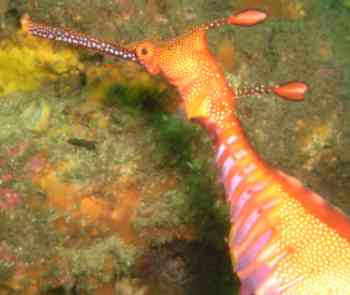 |
| Two red Indianfish on the 15 metres reef | A close up of a common sea dragon at Bare Island |
See First Option above for a description of how to find the pipehorses.
Follow the directions from the location of the pygmy pipehorses in First Option above for the rest of the dive. Note that this dive will take about 50 to 55 minutes. It is more suitable to divers who are not so good on their air as there is less distance to swim but because it goes quicker to depth, not for inexperienced divers. Again, I would recommend a large tank.
Fifth Option - Western Point - THE BEST WAY
The last way to do this dive from the shore is to also walk right to the back right (western) side of Bare Island. You will need extremely calm seas to do this dive. It is preferable to have an incoming tide but you can also do on an outgoing tide so long as there is a not a big difference in the height between low and high. However, you need to be prepared to alter your dive plan should you encounter strong outgoing currents. This can even happen when there is supposed to be an incoming tide!
Enter the water and swim out for 15 metres. Once you descend, head south-west. The depth at first is two metres and it increases to 8 metres over two minutes before flattening out for 30 seconds before dropping again sloping more gradually to about 15 metres. The bottom is rock with kelp and then sand with bits of sponge on rocks. After five minutes you should hit a deeper drop off to 18 metres.
The wall here is very prominent (this is the first wall referred to in Option Three above). There are some overhangs, cracks and even a small cave. On the sand there are also some isolated rocks. Keep an eye out for red indianfish in this area. Along this section of reef there are more sea dragons and in some spots, very prolific fishlife.
On your first dive here you should turn right and follow the reef to the north-west. On later dives you can explore the rocks off here and once more experienced with the site, head south for a bit and then come back around the rocks off the wall.
The the isolated rocks here have lots of nice growth and are home to heaps of things. We regularly see pygmy pipehorses here, as well as red Indianfish. We have also seen sea horses and sea dragons. These rocks also have had pipefish on them at times.
As mentioned above, you can head south for a bit as per Option Three above if you are very experienced and good on your air consumption.
 |  |
| A baby sea dragon on the Deep Wall | A dwarf firefish on the Deep Wall |
From here, go back to the wall and head in a north or north-west direction. Just past here the wall becomes less prominent right on the sand. You will pass the site where the old Admiralty anchor used to be (as mentioned above). There are a couple of small rocks off the main reef edge. Once you see these, within five metres you should see the pygmy pipehorse location as mentioned in First Option.
Follow the directions from the location of the pygmy pipehorses in First Option above for the rest of the dive. Note that this dive will take about 55 to 60 minutes at a minimum, aalthough you could rush and do it in 50 minutes. Again, I would recommend a large tank.
Once you have done this dive a couple of times, you can head south rather than south west from the descent spot and this will take you to the Deep Wall further south and will mean a longer dive of about 60 minutes.
Sixth Option - BY BOAT
Use a boat to get to the site. If you have a boat, you can anchor near 33° 59' 41.1"S 151° 13' 43.5"E (note that all my GPS Readings are using AUS66 - if you use any other datum, you will need to convert the reading - see my GPS Page for more details). This anchor spot is near the southern most wall, caves and overhangs mentioned in Option Three. From the anchor spot head north or north-west till you come to the next lot of caves and then the pygmy pipehorses. Return back and perhaps explore to the south of the anchor spot.
LATEST PYGMY PIPEHORSE SIGHTINGS
We find pygmy pipehorses on every dive here. Once you find them, they normally stay in the one spot for one or two months or even longer. You should be able to find them again if you dive soon after. There is no point in recording them here as unless you dive the site soon after I have spotted them, they probably will have moved on.
To find, get down low and look across the reef. Look for movement that is not in sync with the surge pushing the weed and kelp. The pygmies normally lag a little in the movement.
It is far easier to find them at night as they stand out more when your torch shines on them. It appears that they are more common in the late Spring to early Autumn.
DEEPER REEFS (ISOLATED REEFS)
These are located to the north-west or west (right) from the Cave and Corner area. See Bare Island Isolated Reefs page for more information.
FISHLIFE
As well as the fish mentioned above, you will see bearded cod, beardie, bream, cuttlefish, old wife, mado, stripey, red and blue morwong, maori wrasse, crimson-banded wrasse, mosaic leatherjacket, six-spined leatherjacket, silver sweep, smooth flutemouth, blackspot goatfish, white ear, mullet, sergeant baker, yellow-eyed leatherjacket, pineapplefish (knightfish), snapper, crayfish, abalone, octopus, prawns, shrimp, herring cale, crab, senator wrasse, Port Jackson shark, yellowtail, silver drummer and moray eel. This reef also has some of the most colourful sponge life you will see anywhere in Sydney. Fantastic colours.!
WARNINGS
Things to be aware of on this dive are:
SUMMARY
A fantastic dive site, one of the best in Sydney. Now home to pygmy pipehorses, although they can be very hard to find at times.
| 
 v6.00.307 © 2003-2005
v6.00.307 © 2003-2005